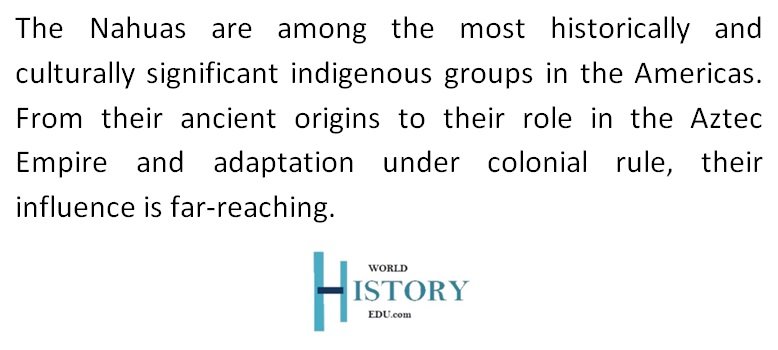
Nahua people’s flag.
The Nahuas are a Uto-Nahuan ethnic group and one of the most significant indigenous populations in Mexico. With historical and cultural ties extending into Central America, Nahua communities exist in Costa Rica, El Salvador, Guatemala, Nicaragua, and Honduras. Below, World History Edu explores their history, language, geography, and cultural identity.
Historical Background
The Nahua peoples are believed to have originated in the northern regions of present-day Mexico, including Durango, Nayarit, or the Bajío region. They migrated into central Mexico around 500 CE and settled in and around the Basin of Mexico. Over time, they spread to become the dominant people in central Mexico.
The Nahuas are a Uto-Nahuan indigenous group, the largest in Mexico, and speakers of Nahuatl.
Nahuas in the pre-Columbian era were divided into multiple groups, each with distinct identities. The Toltecs, who preceded the Mexica (Aztecs), are often considered Nahua, though this is debated. The Mexica, who established the powerful Aztec Empire, and the Tlaxcallans, their primary indigenous rivals, were both Nahua groups. Nahuas played a significant role in shaping the political and cultural landscape of Mesoamerica.
The Spanish conquest (1519-1521) reshaped Nahua society. Many Nahuas, particularly the Tlaxcalans, allied with the Spanish against the Mexica. After the fall of Tenochtitlan, Nahuas adapted to colonial rule, with many becoming intermediaries between indigenous populations and Spanish authorities. Nahuatl remained an essential language in the early colonial period, facilitating administration and conversion efforts by Spanish missionaries.
Following Mexican independence in 1821, indigenous communities, including the Nahuas, lost the legal protections they had under Spanish rule. Liberal reforms sought to dismantle communal landholdings, affecting Nahua agricultural traditions. Despite these challenges, Nahua culture persists, with many continuing to speak Nahuatl and practice traditional customs.
Language and Linguistic Diversity
Nahuatl is the language of the Nahua people, with multiple dialects spoken across Mexico and Central America. It was once the lingua franca of central Mexico and played a crucial role in trade, governance, and religious practice. While approximately 1.6 million Nahuas still speak Nahuatl, another million have transitioned to Spanish.
Nahuatl in Mexico
As of 2023, Nahuatl remains one of the most spoken indigenous languages in Mexico, with over 1.8 million speakers. The highest concentrations are found in Puebla, Veracruz, Hidalgo, San Luis Potosí, and Guerrero. Although the language has declined in some regions, efforts to revitalize Nahuatl have emerged, particularly in education and media.

A pottery sculpture of a Nahua deity originating from Puebla.
Nahuatl in Central America
Smaller Nahua populations exist in El Salvador, Honduras, Nicaragua, and Costa Rica. The Pipil people of El Salvador speak Nawat, a variant of Nahuatl, though it is critically endangered. In Nicaragua and Costa Rica, Nahuatl has largely disappeared as a spoken language but has left a lasting influence on regional place names and cultural practices.
READ ALSO: Religious Practices and Major Deities of Pre-Columbian Civilizations
Nahua Society and Culture
Traditional Nahua society was organized into city-states called altepetl, each with its own ruler and governing structure. Agriculture remains a primary economic activity, with staple crops including maize, beans, squash, and chili peppers. Some Nahuas also engage in animal husbandry, textile production, and artisanal crafts.
Pre-Colonial Nahua religion was polytheistic, centered around deities such as Quetzalcoatl (the Feathered Serpent) and Tlaloc (the Rain God). Rituals included human sacrifice and ceremonies linked to agricultural cycles. With Spanish colonization, Catholicism became dominant, but many indigenous traditions persist in syncretic forms.
Nahua culture is rich in artistic traditions, including music, dance, and storytelling. The netotiliztli (ritual dance) remains an essential part of Nahua festivals. Traditional clothing, including embroidered huipils and rebozos, continues to be worn, particularly by Nahua women.
Despite challenges such as language decline and social marginalization, Nahua identity remains strong through cultural resilience and revitalization efforts.
Population Distribution in Mexico
Nahuatl-speaking communities are primarily concentrated in central and southeastern Mexico. The largest populations are in:
- Puebla
- Veracruz
- Hidalgo
- San Luis Potosí
- Guerrero
Smaller Nahua communities exist in Durango, Morelos, and the State of Mexico. Migration has also led to the presence of Nahua speakers in urban centers like Mexico City.
Nahua Populations in the United States
Due to migration, Nahuatl-speaking communities have emerged in U.S. cities such as Los Angeles, Houston, and New York. These communities maintain cultural ties to their Mexican heritage and contribute to efforts to preserve Nahuatl language and traditions.

Questions and Answers
Where do Nahua populations exist outside of Mexico?
Nahua minorities are found in El Salvador, Guatemala, Honduras, Nicaragua, and Costa Rica.
Are all Nahuas Aztecs?
No, the Mexica (Aztecs) were one Nahua group; others included the Tlaxcaltecs and Toltecs.
How many people speak Nahuatl today?
Around 1.8 million people in Mexico speak Nahuatl, with over 112,000 monolingual speakers.
What is the origin of the Nahuas?
They likely originated in Aridoamerica and migrated to central Mexico around 500 CE.
What does ‘Nahua’ mean?
It derives from the Nahuatl root nāhua, meaning “audible, intelligible, clear.”
How did the Nahuas influence Mesoamerican culture?
They spread Nahuatl as a lingua franca, influenced regional politics, and built powerful states.
What role did the Nahuas play in the Spanish conquest?
Some Nahuas, like the Tlaxcaltecs, allied with the Spaniards against the Aztecs.
How did Nahuatl evolve after Spanish colonization?
It absorbed Spanish loanwords but remained widely spoken and written in colonial documents.
What happened to Nahua identity after Mexican independence?
Indigenous rights declined, and many Nahuas assimilated, losing their language and traditions.
Where are most Nahuatl speakers concentrated today?
Puebla, Veracruz, Hidalgo, Guerrero, and San Luis Potosí have the largest Nahuatl-speaking populations.
What is the status of Nahuatl outside Mexico?
It is endangered in El Salvador and extinct in Nicaragua, Honduras, and Costa Rica.
FACT CHECK: At World History Edu, we strive for utmost accuracy and objectivity. But if you come across something that doesn’t look right, don’t hesitate to leave a comment below.
























